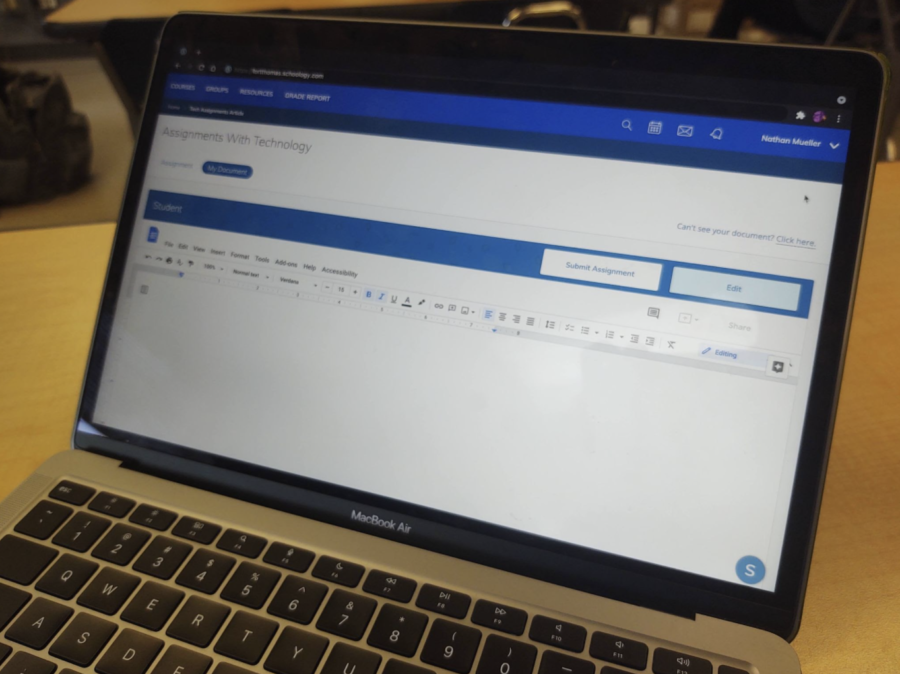A new day: the teacher perspective of the digital integration in education
A MacBook Air displaying a Schoology page with a student assignment.
Say goodbye to boring worksheets and studying from flashcards, the age of technology is here. New digital assignments make Highlands High School students more efficient and creative when doing their work.
However, students may not always get to see the behind-the-scenes creativity, or opinions of the teachers making these assignments. As well as how technology has impacted their day-to-day workload.
Expanding the Possibilities
According to Highlands High School Spanish Teacher Emily Haffey, there are many benefits in working with technology.
“There is so much you can do with technology that [used to take] such a long time without technology readily available.”
Interestingly, while technology has changed certain elements of the teacher’s days, they have managed to retain some of their past teaching methods, while upgrading those elements with technology.
Recordings, posters, and research are all types of work that were done before students received MacBooks. However, teachers will tell you that they have been sped up by technology over recent years.
With all of the tools available due to the newest technology and unrivaled creativity in their toolbox, teachers have been able to create assignments and activities they couldn’t do in the past.
Due to new technological advancements, there are more opportunities for teachers and students alike, according to Haffey.
“Students have connected with a school in California, a school filled with immigrants and they have connected with lawers in Chile.”
Math Teacher Ryan Mahoney talked about how technology expanded the possibilities in his class.
“Yes, it expands the possibilities of creating unique assignments. For example, in my Algebra 1 classes, I have been able to help students develop their skills using Microsoft Excel. Since we study both tables and graphs of various data.”
Talking with Haffey about assignments made it incredibly clear that things like recordings and projects are enhanced due to this. Although she also talked about why the traditional way of teaching still has a place in modern classrooms”
“I feel like students get more out of the traditional way of teaching, even though they may not like it.”
According to Digital Learning Coach Brian Mercer, while students have grown up in the days of laptops and smartphones, some teachers have gone through a learning curve when using these new tools.
“Faculty, sometimes they want to do something good, something different but they’re a little bit leery of that. If someone is there behind them we’ll help them through that, that’s what I do.”
With the right help and resources, teachers can make some truly innovative assignments and activities that improve the school experience for students of all grade levels.
Downsides of Digital Integration
One thing Sophomore Griffin Sanders believes is that technology speeds up learning due to the new M1 Macbooks.
“I feel like the technology that we use at school has enabled work to be done faster which has increased the frequency of assignments. I think this adds some stress in school.”
Students are bombarded with more and more assignments from each one of their classes, but the teachers, who are the ones creating the assignments, have the same problem.
According to Haffey, the teachers have the same stress due to the increase of teaching with technology.
“I feel like when we used to plan, paper-pencil, everything was textbook driven. It would take a day to finish a worksheet or finish a couple pages of a book, now we can do a couple of clicks of a computer and it’s over.”
There are also frequent frustrations that technology creates, according to Mahoney.
“If a class is using a program that they have no prior experience with, it can certainly be frustrating because you are both trying to learn the in’s and out’s of the program while also attempting to effectively complete the assignment.”
Mahoney, being a math teacher uses the infamous program known as Mathia. Every student knows the feeling of fear and frustration running down their spine while they rush to finish a workspace, and every parent has heard their student scream at Mathia at least once. Although, Mahoney believes that there are still pros to this program.
“I think a pro to using Mathia is that it can be extremely helpful for visual learners. The program does a great job in creating examples where students can physically interact with tables, graphs, and diagrams and manipulate various characteristics about the visuals.”
But he does see the bad elements of the program that students are very vocal about.
“One con, I would say, is that the program isn’t always clear on what exactly it wants the students to do. So, sometimes, it gets to be frustrating as the users are clicking or typing things to try and guess what the program is asking for.”
Conclusion
The answer to the question, does technology help teachers, seems to be a yes, for multiple reasons.
Whether it be the overwhelming saving of time or the overflowing possibilities that technology creates, the one thing we know for sure is that teachers happy about the benefits and willing to work around the negatives.
All of this is best summed by a quote from Sanders.
“I am excited to see what teachers will do with the MacBooks and how it will influence their classes and their students.”













